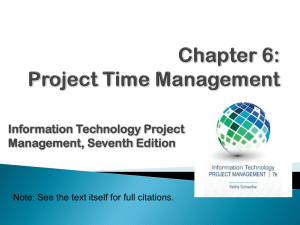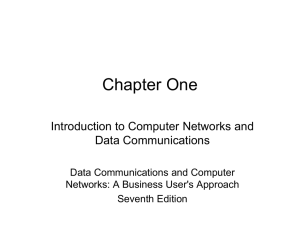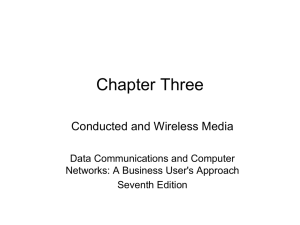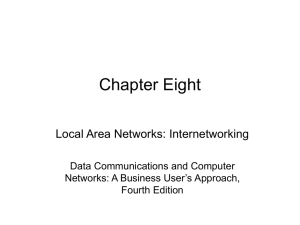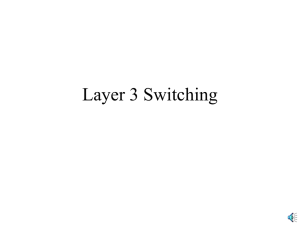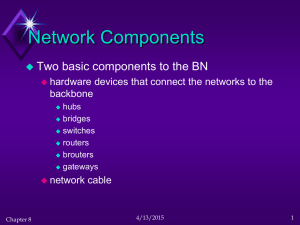Chapter Seven
advertisement
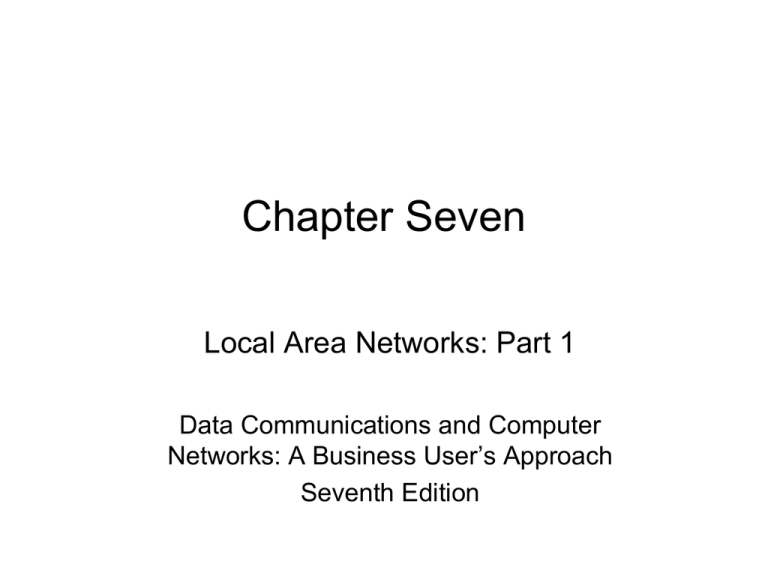
Chapter Seven Local Area Networks: Part 1 Data Communications and Computer Networks: A Business User’s Approach Seventh Edition After reading this chapter, you should be able to: • State the definition of a local area network • List the primary function, activities, and application areas of a local area network • Cite the advantages and disadvantages of local area networks • Identify the physical and logical layouts (topologies) of local area networks Data Communications and Computer Networks: A Business User's Approach, Seventh Edition 2 After reading this chapter, you should be able to (continued): • Specify the different medium access control techniques • Recognize the different IEEE 802 frame formats • Describe the common local area network systems Data Communications and Computer Networks: A Business User's Approach, Seventh Edition 3 Introduction • A local area network is a communication network that interconnects a variety of data communicating devices within a small geographic area and broadcasts data at high data transfer rates • Since the local area network first appeared in the 1970s, its use has become widespread in commercial and academic environments Data Communications and Computer Networks: A Business User's Approach, Seventh Edition 4 Primary Function of Local Area Networks • To provide access to hardware and software resources that will allow users to perform one or more of the following activities: – File serving • A large storage disk drive acts as a central storage repository – Print serving • Providing the authorization to access a particular printer, accept and queue print jobs, and providing a user access to the print queue to perform administrative duties – Video transfers • High speed LANs are capable of supporting video image and live video transfers Data Communications and Computer Networks: A Business User's Approach, Seventh Edition 5 Primary Function of Local Area Networks (continued) • To provide access to hardware and software resources that will allow users to perform one or more of the following activities (continued): – Manufacturing support • LANs can support manufacturing and industrial environments – Academic support • In classrooms, labs, and wireless – E-mail support – Interconnection between multiple systems Data Communications and Computer Networks: A Business User's Approach, Seventh Edition 6 Primary Function of Local Area Networks (continued) Data Communications and Computer Networks: A Business User's Approach, Seventh Edition 7 Advantages and Disadvantages of Local Area Networks • Advantages – – – – Ability to share hardware and software resources Individual workstation might survive network failure Component and system evolution are possible Support for heterogeneous forms of hardware and software – Access to other LANs and WANs (Figure 7-1) – Private ownership (maybe a disadvantage) – Secure transfers at high speeds with low error rates Data Communications and Computer Networks: A Business User's Approach, Seventh Edition 8 Advantages and Disadvantages of Local Area Networks (continued) • Disadvantages – – – – – Equipment and support can be costly Level of maintenance continues to grow Private ownership (lease option attractive for some) Some types of hardware may not interoperate Just because a LAN can support two different kinds of packages does not mean their data can interchange easily – LAN is only as strong as its weakest link, and there are many links Data Communications and Computer Networks: A Business User's Approach, Seventh Edition 9 The First Local Area Network – The Bus/Tree • The original topology • Workstation has a network interface card (NIC) that attaches to the bus (a coaxial cable) via a tap • Data can be transferred using either baseband digital signals or broadband analog signals Data Communications and Computer Networks: A Business User's Approach, Seventh Edition 10 Bus/Tree (continued) Data Communications and Computer Networks: A Business User's Approach, Seventh Edition 11 Bus/Tree (continued) Data Communications and Computer Networks: A Business User's Approach, Seventh Edition 12 Bus/Tree (continued) • Baseband signals are bidirectional and more outward in both directions from the workstation transmitting • Broadband signals are usually uni-directional and transmit in only one direction – Because of this, special wiring considerations are necessary • Buses can be split and joined, creating trees Data Communications and Computer Networks: A Business User's Approach, Seventh Edition 13 Bus/Tree (continued) Data Communications and Computer Networks: A Business User's Approach, Seventh Edition 14 Bus/Tree (continued) Data Communications and Computer Networks: A Business User's Approach, Seventh Edition 15 A More Modern LAN – The Star-Wired Bus • Logically operates as a bus, but physically looks like a star • Star design is based on hub – All workstations attach to hub • Unshielded twisted pair usually used to connect workstation to hub • Originally, hub takes incoming signal and immediately broadcasts it out all connected links • Hubs can be interconnected to extend size of network Data Communications and Computer Networks: A Business User's Approach, Seventh Edition 16 Star-Wired Bus (continued) Data Communications and Computer Networks: A Business User's Approach, Seventh Edition 17 Star-Wired Bus (continued) Data Communications and Computer Networks: A Business User's Approach, Seventh Edition 18 Star-Wired Bus (continued) • Modular connectors and twisted pair make installation and maintenance of star-wired bus better than standard bus • Hubs can be interconnected with twisted pair, coaxial cable, or fiber-optic cable • Biggest disadvantage: when one station talks, everyone hears it – This is called a shared network • All devices are sharing the network medium Data Communications and Computer Networks: A Business User's Approach, Seventh Edition 19 Medium Access Control Protocols • How does a workstation get its data onto the LAN medium? • A medium access control protocol is the software that allows workstations to “take turns” at transmitting data • Two basic categories: – Contention-based protocols – Round-robin protocols Data Communications and Computer Networks: A Business User's Approach, Seventh Edition 20 Contention-Based Protocols • Essentially first-come, first-served • Most common example is carrier sense multiple access with collision detection (CSMA/CD) • If no one is transmitting, workstation can transmit • If someone else is transmitting, workstation “backs off” and waits Data Communications and Computer Networks: A Business User's Approach, Seventh Edition 21 Contention-Based Protocols (continued) • If two workstations transmit at same time, collision occurs – When two workstations hear collision, they stop transmitting immediately – Each workstation backs off a random amount of time and tries again – Hopefully, both workstations do not try again at exact same time • CSMA/CD is an example of a non-deterministic protocol Data Communications and Computer Networks: A Business User's Approach, Seventh Edition 22 Contention-Based Protocols (continued) Data Communications and Computer Networks: A Business User's Approach, Seventh Edition 23 Switches • The hub is a simple device that transmits an incoming frame out all the other ports on the hub • The switch has intelligence and can filter out and forward frames based on their NIC address • A switch maintains internal port table(s) that keep track of which frames arrived on which ports • Switches have eliminated many hubs Data Communications and Computer Networks: A Business User's Approach, Seventh Edition 24 Switches (continued) Data Communications and Computer Networks: A Business User's Approach, Seventh Edition 25 Switches (continued) • A switch observes each frame that arrives at a port, extracts the source address from the frame, and places that address in the port’s routing table • A transparent switch is found with CSMA/CD LANs Data Communications and Computer Networks: A Business User's Approach, Seventh Edition 26 Switches (continued) Data Communications and Computer Networks: A Business User's Approach, Seventh Edition 27 Switches (continued) Data Communications and Computer Networks: A Business User's Approach, Seventh Edition 28 Switches (continued) • Workstations that connect to a hub are on a shared segment • Workstations that connect to a switch are on a switched segment • The backplane of a switch is fast enough to support multiple data transfers at one time Data Communications and Computer Networks: A Business User's Approach, Seventh Edition 29 Switches (continued) • A switch that employs cut-through architecture is passing on frame before entire frame has arrived at switch • Multiple workstations connected to a switch use dedicated segments – This is a very efficient way to isolate heavy users from the network • Switches can allow simultaneous access to multiple servers, or multiple simultaneous connections to a single server Data Communications and Computer Networks: A Business User's Approach, Seventh Edition 30 Switches (continued) Data Communications and Computer Networks: A Business User's Approach, Seventh Edition 31 Isolating Traffic Patterns and Providing Multiple Access • Whether shared or dedicated segments are involved, the primary goal of a switch is to isolate a particular pattern of traffic from other patterns of traffic or from the remainder of the network • Switches, because of their backplane, can also allow multiple paths of communications to simultaneously occur Data Communications and Computer Networks: A Business User's Approach, Seventh Edition 32 Switches (continued) Figure 7-13 A switch with two servers allowing simultaneous access to two servers Data Communications and Computer Networks: A Business User's Approach, Seventh Edition 33 Full-Duplex Switches • Allow for simultaneous transmission and reception of data to and from a workstation • This full-duplex connection helps to eliminate collisions • To support a full-duplex connection to a switch, at least two pairs of wires are necessary – One for the receive operation – One for the transmit operation – Most people install four pairs today, so wiring is not the problem Data Communications and Computer Networks: A Business User's Approach, Seventh Edition 34 Virtual LANs • Virtual LAN (VLAN) – logical subgroup within a LAN that is created via switches and software rather than by manually moving wiring from one network device to another • Even though employees and their actual computer workstations may be scattered throughout the building, LAN switches and VLAN software can be used to create a “network within a network” Data Communications and Computer Networks: A Business User's Approach, Seventh Edition 35 Virtual LANs (continued) • A relatively new standard, IEEE 802.1Q, was designed to allow multiple devices to intercommunicate and work together to create a virtual LAN • Instead of sending technician to a wiring closet to move a workstation cable from one switch to another, an 802.1Q-compliant switch can be remotely configured by a network administrator Data Communications and Computer Networks: A Business User's Approach, Seventh Edition 36 Virtual LANs (continued) Figure 7-14 A switch with two VLANs configured Data Communications and Computer Networks: A Business User's Approach, Seventh Edition 37 Link Aggregation • Allows you to combine two or more links into one higher-speed link • Why would we want to do this? – What if you want more bandwidth between a device and a switch? – What if you want to provide a back-up link between a device and a switch? – What if you want to provide a higher-speed connection to a server? Data Communications and Computer Networks: A Business User's Approach, Seventh Edition 38 Link Aggregation • An IEEE protocol (802.3ad-2000) which typically runs in most LAN devices can support link aggregation • Link aggregation attempts to balance the flow of messages over the multiple paths, unless the flow of frames belong to a particular conversation; then the frames are sent over one of the links. Data Communications and Computer Networks: A Business User's Approach, Seventh Edition 39 Spanning Tree Algorithm • What if you have a large set of networks interconnected with many switches? • Because of this large set of networks, a loop has been created in which a frame can circle through the networks and actually return to the originating device Data Communications and Computer Networks: A Business User's Approach, Seventh Edition 40 Spanning Tree Algorithm Figure 7-15 A circular interconnection of local area networks and switches Data Communications and Computer Networks: A Business User's Approach, Seventh Edition 41 Spanning Tree Algorithm • Is this loop or circle of connections a mistake? • Not necessarily. What if the network designers wanted to create a network with two possible paths to each device (in event of a failure)? • We want to leave the physical loop in place, but want to logically remove the loop (alter the forwarding tables of the switches such that the loop no longer exists) • How do we logically remove this loop? Data Communications and Computer Networks: A Business User's Approach, Seventh Edition 42 Spanning Tree Algorithm • The spanning tree algorithm (used in Spanning Tree Protocol and now Rapid Spanning Tree Protocol) runs in switches and can identify loops and remove them • How does the spanning tree algorithm work? Four steps: – Identify a switch as the root switch – Visit each switch and identify the one port that has the shortest path back to the root switch. Mark these ports with RP (root port) Data Communications and Computer Networks: A Business User's Approach, Seventh Edition 43 Spanning Tree Algorithm • How does the spanning tree algorithm work? Continued: – Visit each LAN and identify the port that provides the shortest path back to the root switch. Mark these ports with a DP (designated port). – Are there any ports remaining that don’t have either an RP or DP designation? Mark those ports as Removed. (They aren’t physically removed, only removed in the forwarding tables) Data Communications and Computer Networks: A Business User's Approach, Seventh Edition 44 Spanning Tree Algorithm Figure 7-16 Network interconnection indicating root switch, root ports, designated ports, and removed connections Data Communications and Computer Networks: A Business User's Approach, Seventh Edition 45 Quality of Service • On a standard Ethernet LAN, all frames have the same priority, which is none • What if you want to make video-conferencing frames a higher priority than email frames? • You can use IEEE 802.1p standard which is installed in most if not all switches • The 802.1p standard adds a 3-bit field to the front of each Ethernet frame • This 3-bit field can be used to establish a priority Data Communications and Computer Networks: A Business User's Approach, Seventh Edition 46 Quality of Service • Here are the PCP values and the associated traffic types PCP Value Traffic Type 0 1 2 3 4 5 6 7 Best effort Background (lowest priority) Excellent effort Critical applications Video Voice Internetwork control Network control (highest priority) Data Communications and Computer Networks: A Business User's Approach, Seventh Edition 47 Wired Ethernet • Most common form of LAN today • Star-wired bus is most common topology but bus topology still not totally dead yet • Comes in many forms depending upon medium used and transmission speed and technology Data Communications and Computer Networks: A Business User's Approach, Seventh Edition 48 Wired Ethernet (continued) • Originally, CSMA/CD was 10 Mbps • Then 100 Mbps was introduced – Most NICs sold today are 10/100 Mbps • Then 1000 Mbps (1 Gbps) was introduced • 10 Gbps is now being installed in high-end applications Data Communications and Computer Networks: A Business User's Approach, Seventh Edition 49 Wired Ethernet (continued) • 1000 Mbps introduces a few interesting wrinkles: – Transmission is full-duplex (separate transmit and receive), thus no collisions – Prioritization is possible using 802.1p protocol • Topology can be star or mesh (for trunks) Data Communications and Computer Networks: A Business User's Approach, Seventh Edition 50 Wired Ethernet (continued) Data Communications and Computer Networks: A Business User's Approach, Seventh Edition 51 Wired Ethernet (continued) • One of the more recent features is power over Ethernet (PoE) • What if you have a remote device that has an Ethernet connection? – It will require a power connection • What if you don’t have an electrical outlet nearby? – Use PoE • Power to drive Ethernet NIC is sent over wiring along with usual Ethernet signals Data Communications and Computer Networks: A Business User's Approach, Seventh Edition 52 IEEE 802 • To better support local area networks, the data link layer of the OSI model was broken into two sublayers: – Logical link control sublayer – Medium access control sublayer • Medium access control sublayer defines frame layout and is more closely tied to a specific medium at the physical layer – Thus, when people refer to LANs they often refer to its MAC sublayer name, such as 10BaseT Data Communications and Computer Networks: A Business User's Approach, Seventh Edition 53 IEEE 802 (continued) Figure 7-17 Modification of OSI model to split data link layer into two sublayers Data Communications and Computer Networks: A Business User's Approach, Seventh Edition 54 IEEE 802.3 Frame Format • IEEE 802 suite of protocols defines frame formats for CSMA/CD (IEEE 802.3) and token ring (IEEE 802.5) • Each frame format describes how data package is formed • The two frames do not have the same layout – If a CSMA/CD network connects to a token ring network, the frames have to be converted from one to another Data Communications and Computer Networks: A Business User's Approach, Seventh Edition 55 IEEE 802.3 Frame Format (continued) Figure 7-18 Frame format for IEEE 802.3 CSMA/CD Data Communications and Computer Networks: A Business User's Approach, Seventh Edition 56 LANs In Action: A Small Office Solution • What type of system will interconnect 20 workstations in one room and 15 workstations in another room to a central server, which offers: – Internal e-mail – A database that contains all customer information – High-quality printer access Data Communications and Computer Networks: A Business User's Approach, Seventh Edition 57 LANs In Action: A Small Office Solution (continued) Figure 7-19 Wiring diagram of Hannah’s office space showing the placement of switches and servers Data Communications and Computer Networks: A Business User's Approach, Seventh Edition 58 LANs In Action: A Small Office Solution (continued) Figure 7-20 The modified network with a router and highspeed phone line Data Communications and Computer Networks: A Business User's Approach, Seventh Edition 59 Summary • Primary functions of a LAN are to enable sharing of data, software, and peripherals and to provide common services such as file serving, print serving, support for electronic mail, and process control and monitoring in office, academic, and manufacturing environments • Local area networks have numerous advantages and disadvantages • A LAN can be configured as a bus/tree topology, a star-wired bus topology, or a wireless network Data Communications and Computer Networks: A Business User's Approach, Seventh Edition 60 Summary (continued) • With both baseband and broadband buses, expansion in the form of adding a new workstation is difficult when a tap is not available • For a workstation to place data onto a LAN, network must have a medium access control protocol – Two basic forms of medium access control protocols are: • Contention-based • Round-robin • CSMA/CD works on first-come, first-served basis, supports half-duplex and full-duplex connections, and is clearly the most popular access protocol Data Communications and Computer Networks: A Business User's Approach, Seventh Edition 61 Summary (continued) • To standardize the medium access control protocols, IEEE created the 802 series of network standards • Virtual LANs allow network administrators to create subgroups of devices on a LAN • The IEEE 802.1q standard supports virtual LANs Data Communications and Computer Networks: A Business User's Approach, Seventh Edition 62 Summary (continued) • Link aggregation allows one to combine two or more data paths or links into one higher-speed link • Link aggregation is supported by the IEEE 802.3ad-2000 standard • The Spanning Tree Algorithm can be used to eliminate cycles within larger local area network installations • The Rapid Spanning Tree Protocol incorporates the Spanning Tree Algorithm Data Communications and Computer Networks: A Business User's Approach, Seventh Edition 63 Summary (continued) • Many forms of wired Ethernet exist, including twisted pair and fiber optic versions, from 10 Mbps up to 10 Gbps, with even faster versions on the near horizon • The basic Ethernet frame consists of an 8-byte header, two 6-byte NIC addresses, a length or type field, a data field, an optional pad field, and a 4-byte checksum Data Communications and Computer Networks: A Business User's Approach, Seventh Edition 64



